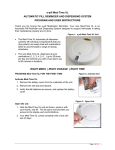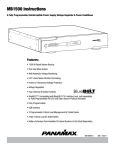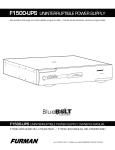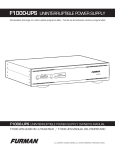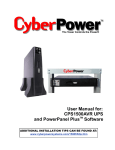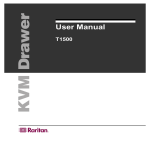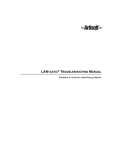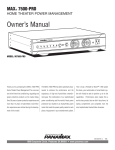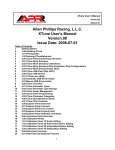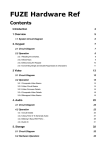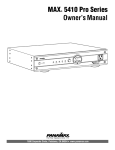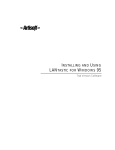Download Panamax M1500-UPS User's Manual
Transcript
MAX Home Cinema UPS Owner’s Manual ® Pure Sine Wave al Load Control Intelligent Critic POWER ON TEST POWER BATTERY LEVEL LOAD LEVEL LINE FAULT E UNSAFE VOLTAG BATTERY MODE AVR MODE M1500-UPS 1690 Corporate Circle, Petaluma, CA 94954 • www.panamax.com MAX® Home Cine ma UPS Table of Contents Important Safety Instructions.............................................................pg. 1 Battery Features........................................................................pgs. 10, 11 Installing Your UPS.............................................................................pg. 2 Diagnostics.......................................................................................pg. 11 Basic Operation.............................................................................pgs. 2, 3 Troubleshooting................................................................................pg. 12 Advanced Operation......................................................................pgs. 4, 5 Technical Specifications....................................................................pg. 12 Home Cinema Power Control Software Installation Instructions...pgs. 5, 6 RS232 Communications Protocol & Command Set.....pgs. 13, 14, 15, 16 Home Cinema Power Control Software Instructions............pgs. 7, 8, 9, 10 FCC Notice and Warranties..............................................................Pg. 17 Before You Begin UNPACKING Inspect the UPS upon receipt. In addition to this manual the box should contain the following: 2. Power Cord 1. UPS Unit 3. Phone Cord Pure Sine Wave Load Control Intelligent Critical POWER ON TEST POWER BATTERY LEVEL LINE FAULT LOAD LEVEL UNSAFE VOLTAGE BATTERY MODE AVR MODE 5. Rack Mounting Kit MAX® Home Cinema UPS 6. Home Cinema Power Control Software Please verify that you have received all these items. If not, contact Panamax. PANAMAX, the Panamax logo and MAX are registered US trademarks of Panamax. Protect or Disconnect, and SignalPerfect are trademarks of PANAMAX. SIDACtor is a registered US trademark of Teccor Electronics, Inc. TiVo is a trademark of TiVo, Inc. © 2005 PANAMAX CORP. All Rights Reserved. 4. DB 9 Serial Cable Important Safety Instructions This manual contains important instructions that should be followed during installation and maintenance of the UPS and batteries. Please read and follow all instructions carefully during installation and operation of the unit. Read this manual thoroughly before attempting to unpack, install, or operate. CAUTION! The UPS must be connected to an AC power outlet with fuse or circuit breaker protection. CAUTION! To reduce the risk of electric shock, do not remove the cover, except to service the battery. No user serviceable parts inside, except for the battery. DO NOT plug the machine into an outlet that is not grounded. If you need to de-energize this equipment, turn off and unplug the UPS. CAUTION! To avoid electrical shock, turn off the unit and unplug it from the AC power source before servicing the battery or installing a component. CAUTION! DO NOT USE FOR MEDICAL OR LIFE SUPPORT EQUIPMENT! Panamax does not sell products for life support or medical applications. DO NOT use in any circumstance that would affect operation or safety of any life support equipment, with any medical applications, or patient care. CAUTION! DO NOT USE WITH OR NEAR AQUARIUMS! To reduce the risk of fire, do not use with or near aquariums. Condensation from the aquarium can come in contact with metal current contacts and cause the machine to short out. CAUTION! The battery can energize hazardous live parts inside even when the AC input power is disconnected. CAUTION! To prevent the risk of fire or electric shock install in a temperature and humidity controlled indoor area, free of conductive contaminants. (Please see specifications for acceptable temperature and humidity range). Pure Sine Wave al Load Control Intelligent Critic POWER ON TEST POWER BATTERY LEVEL LOAD LEVEL LINE FAULT E UNSAFE VOLTAG BATTERY MODE ma UPS AVR MODE MAX® Home Cine MODEL # M1500-UPS CAUTION! The 2 silver handles on the battery access panel are for removing the panel only. NOT FOR LIFTING PRODUCT. USA & Canada (800) 472-5555 • (707) 283-5900 • Fax (707) 283-5901 1 Installing Your UPS HARDWARE INSTALLATION GUIDE 1. Your new UPS may be used immediately upon receipt. However, recharging the battery for at least four hours is recommended to insure that the battery’s maximum charge capacity is achieved. Charge loss may occur during shipping and storage. To recharge the battery, simply leave the unit plugged into an AC outlet. The unit will charge in both the ON as well as the OFF position. If you wish to use the software, connect the enclosed serial interface cable to the serial port on the UPS and an open serial port on the computer. 4. Plug the UPS into a 2 pole, 3 wire grounded receptacle (wall outlet). Make sure the wall branch outlet is protected by a fuse or circuit breaker and does not service equipment with large electrical demands (e. g. refrigerator, copier, etc.) Avoid using extension cords. If used, the extension cord must be rated for 15 Amps. 2. With the UPS unit OFF and unplugged, plug your home theater equipment into the unit’s rear panel AC outlets. DO NOT plug a laser printer, copier, space heater, vacuum cleaner, paper shredder or other large electrical device into the UPS. The power demands of these devices will overload and possibly damage the unit. 6. The rear panel circuit breakers will open and power to the connected equipment will be turned OFF if an overload is detected. To correct this, turn the UPS off, unplug at least one piece of equipment, wait 10 seconds, check to make sure that the circuit breakers are reset, and turn the unit on. 3. To protect a telephone modem line (DVR or Satellite TV receiver) or network cable, connect a telephone cable or network cable from the wall jack outlet to the IN jack of the UPS. Then connect a telephone cable or network cable from the OUT jack on the UPS to the equipment’s telephone jack or network device. Note: This unit provides both telephone and LAN protection on one set of RJ-11/45 jacks. The telephone cirLAN TEL cuit uses pins 4 & 5 while the LAN circuit uses pins 1, 2, 3 & 6. Adapters or custom cables 1 2 3 4 5 6 7 8 (not included) must be used when utilizing RJ-45 both protection circuits at the same time. 5. Press the power switch to turn the UPS on. The Power ON indicator light will illuminate. 7. The UPS will automatically charge the battery whenever it is plugged into an AC outlet, 8. To maintain optimal battery charge, leave the UPS plugged into an AC outlet at all times. 9. To store your UPS for an extended period, cover it and store with the battery fully charged. Recharge the battery every three months to insure battery life. Basic Operation FRONT PANEL DESCRIPTION Power Switch Test Switch Removable Access Panel Press the power button to turn the UPS ON or OFF. This UPS performs a self-test automatically when powered on. The test switch allows you to test the system at any time. When the UPS passes the test, it returns to online operation. If the UPS fails the self-test, please recharge the battery for 4 hours and perform another self-test. If it fails after recharging the battery, please replace the battery. In battery mode, you can press this button to silence an audible alarm. Easy to remove for battery access and replacement. POWER DO NOT lift product with handles. They are for panel removal only. POWER ON TEST BATTERY LEVEL LINE FAULT UNSAFE VOLTAGE LOAD LEVEL Pure Sine Wave Intelligent Critical Load Control BATTERY MODE AVR MODE MAX® Home Cinema UPS 2 USA & Canada (800) 472-5555 • (707) 283-5900 • Fax (707) 283-5901 Basic Operation (continued) FRONT PANEL DISPLAY LED DESCRIPTIONS Power On Indicator Line Fault Indicator Unsafe Voltage Indicator This LED is illuminated when the utility condition is normal and the UPS outlets are providing clean, protected power. This LED will illuminate to warn the user that a wiring problem such as a bad/missing ground or reversed wiring exists within the AC receptacle. If illuminated, disconnect all equipment and contact an electrician to insure outlet is properly wired. This LED will illuminate to inform the user that an unsafe line voltage is present and that the UPS has switched to battery power. This could be either an over-voltage or under-voltage. POWER ON Load Level Indicator Battery Level Indicator LINE FAULT BATTERY LEVEL This is a visual indication of the battery charge. If battery capacity is under 25%, no indicator LED will illuminate and UPS starts beeping (if the audible alarm is enabled). This is a visual indication of the UPS load. LOAD LEVEL UNSAFE VOLTAGE The 1st arrow will illuminate when the load is above 25%, the 2nd above 50% and the 3rd above 75%. The 4th arrow will flash when the load is between 85% and 100%. 1 2 3 4 BATTERY MODE AVR MODE Battery Mode Indicator AVR Indicator This illuminates during utility failure or an unsafe voltage condition, indicating that the battery is supplying power to the connected equipment. This indicates that the UPS is operating in automatic voltage regulation mode. When the led is illuminated continuously, it indicates an input over-voltage and the UPS unit reduces (bucks) the voltage to the normal operating range. When the led is flashing, it indicates that the input line voltage is low and that the UPS is increasing (boosts) input voltage to the normal range. REAR PANEL DESCRIPTION Non-Critical-Load Outlets Critical Load Outlets Four battery powered, surge protected and AVR outlets for connected equipment insures temporary uninterrupted operation of connected equipment during a power failure. Two battery powered, surge protected and AVR outlets for critical-load equipment insures temporary uninterrupted operation of connected equipment during a power failure. AC Power Cord Input Receptacle IR Control Section Learning Control Switches – Push to program or test the IR function IR Detector Window – Receives the IR signal to be learned Indicator LED’s – Indicates learning status Output Delay Switches – Set the desired time delay between a power failure and when the IR signals are sent to the connected equipment IR Output Jacks – Standard 1/8” (3.5mm) mono jack for connection to an IR flasher (IR flashers not included) OUTPUT DELAY NON CRITICAL LOAD OUTLET BANK 3 30 SEC. MAIN 1 2 CRITICAL LOAD OUTLET BANK IR DETECTOR IR1 5 MIN. IR2 AC INPUT IR OUTPUT PROGRAM / TEST IN OUT RS232 CONTROL Circuit Breakers for Overload Protection Resettable circuit breakers provide optimal overload protection. RS232 Serial Communication Port RJ11/RJ45 Jacks The serial port allows connection and communication between the UPS and a HTPC (home theater personal computer) or home automation system. If used temporarily during setup (with the included software), it allows the installer to program a number of variables including the Critical Load Battery Threshold. See the software documentation for more information. Ports protect standard telephone line, modem, or network cable. USA & Canada (800) 472-5555 • (707) 283-5900 • Fax (707) 283-5901 3 Advanced Operation Audio/Video components such as Digital Video Recorders, DLP projectors and any component with volatile memory can benefit from connection to a UPS. The Panamax M1500-UPS takes this to the next level with a number of features designed specifically for the home theater. Critical Load Function One of the user programmable settings in the Home Cinema Power Control software is the Low Battery NCL Shutoff threshold. This sets the battery capacity level at the point where the non-critical load outlets are turned off and all remaining battery power is reserved for equipment plugged into the 2 critical load outlets. This value is stored internally by the UPS and is not dependent on having the software running on a computer. Learning IR Control The learning IR function lets you program the UPS to send standby or shut-down commands to components such as DLP ceiling projectors. If the power fails, the projector’s lamps are turned off while the UPS continues providing battery power to the projector’s cooling fan. Proper shutdown is ensured and expensive lamps are protected from damage. Note: This function should only be used with discrete IR codes. Programming an On/Off toggle command could result in the equipment being turned ON during a power failure! IR LED Color & Status LED COLOR Off Green, solid Green, flashing Red, flashing STATUS Idle Waiting to receive IR signal IR signal sampled Failed to learn IR signal To program IR output: 1. Press and hold the IR1 button for approximately 2 seconds. 2. When the IR1 LED turns solid GREEN, release the button (after approx. 2 seconds) 3. Point the remote control at the detector window and quickly press and release the appropriate button on the remote control. If no signal is received within 10 seconds, the programming mode is cancelled, the IR1 LED turns off and you will have to start over. 4. The IR1 LED flashes GREEN if the IR signal is sampled and stored in memory. IR Power Failure Operation The UPS can learn two IR commands. The learned commands will be transmitted on both output jacks so you have the ability to control 2 different pieces of equipment or use a 2-step macro for one component. 5. The IR1 LED will flash RED if the IR signal was not learned. Start over at Step 1. The IR Output Delay switches provide the ability to “ridethrough” brief power outages without sending a shut-down signal to the connected device. You have a choice of a 30 second or 5 minute delay. To clear IR programming: 1. Press and hold the appropriate IR button, release after 2 sec. 1. After a power failure and the selected delay, the IR codes will be sent to both outputs. The IR LED’s will flash once per second during the delay time and will stop flashing after the IR code is output. 3. Press the button again. The IR code will be erased from memory and the LED will turn off. 2. If the delay settings are the same for both IR1 and IR2, the IR2 code will be sent to both outputs 2 seconds after IR1. 3. The IR commands will also be transmitted immediately after the battery charge falls below the critical load battery threshold. This ensures that equipment will be shutdown properly if the UPS’s load level is extremely high and the backup time would be less than the 5 minute ride-through delay. 4. There is no IR output after the power is restored to the system. 4 6. Repeat steps 1-5 for IR2. 2. The IR LED turns solid Green IR Output Test 1. An IR flasher must be connected to the UPS and in line-ofsight to the IR receiver window of the equipment to be controlled in order to verify that the code was learned correctly. 2. Make sure that the component to be controlled is turned ON. 3. Press and release the IRx button. The code for IRx will be transmitted on both IR1 and IR2 outputs. 4. If you are testing a 2-step macro, be sure to press the second IR button to transmit that code. USA & Canada (800) 472-5555 • (707) 283-5900 • Fax (707) 283-5901 Advanced Operation (continued) 5. If the learning process was successful, the controlled equipment should accept the IR command and turn off or go into standby mode. 6. Reprogram the IR command if the controlled equipment does not respond. a. Be sure that the batteries in the “teaching remote” are fresh and do not need to be replaced. b. If “press & release” (Step 3 in Programming) doesn’t work, try “press & hold” on the remote control button being taught to the UPS. RS232 Control with Open Protocol The RS232 serial interface can be used in the following ways: 1. Initial system setup. An installer can use a notebook computer to set the variables within the Home Cinema Power Control software. Once the setup is completed, the notebook computer can be disconnected. All settings are stored in the UPS. 2. Connection to a Home Theater Personal Computer (HTPC). Functionality is very similar to a standard UPS with a PC. The UPS can provide continued power to the HTPC to maintain recording capabilities if it is being used as a digital video recorder. It is also capable of saving open documents and shutting down the HTPC during extended power failures. This requires a permanent RS232 connection to the HTPC and having the Home Cinema Power Control software running in the background on the HTPC. 3. Integration with home automation systems like AMX and Crestron. The serial communications command set and protocol is open and is published later in this manual. This information can be used by the automation system programmer for both UPS control by the automation system and reporting of power events by the UPS to the automation system. Home Cinema Power Control Software The M1500-UPS has one rear-panel serial port that provides the ability to program special functions, safely shutdown a home theater PC (HTPC) or integrate the UPS with home automation systems. Use of the Panamax software is optional. The communications protocol is “open”; a programmer can write their own control program or integrate the UPS’s programming/control functions into home automation software if desired. The UPS will provide surge suppression, automatic voltage regulation and battery backup without the software. Automatic shutdown of an HTPC requires the use of the software. 7. Plug the UPS into an AC outlet, turn the UPS on and start your computer. Software Installation 11. Once the software has finished installing, remove the disk and restart your computer. 8. Windows will recognize your UPS as “New Hardware”. 9. Insert the software disk into the computer’s drive. The installation program should start automatically. If the installation program does not start automatically, open it manually with the Window’s “Run” command. 10. Follow the on-screen instructions. For Windows XP (Home and Professional) 1. Click on Start and then click on Control Panel. 2. Double-click on Power Options then click on the UPS tab. 3. Set the manufacturer to none. 4. Exit to the desktop and shutdown your computer. 5. Turn the UPS off and unplug it. 6. Connect the serial interface cable to the UPS and an open serial port on the back of the computer. (Note: You must use the serial cable that was supplied with the unit). For Windows 95/98/Me 1. Turn off your UPS. 2. Connect the Serial Cable to your UPS and the open serial port on the rear panel of the computer. (Note: You must use the serial cable that was supplied with the unit). 3. Plug the UPS into an AC outlet, turn the UPS on and then start your computer. 4. Follow the instructions below for your PC’s operating system. USA & Canada (800) 472-5555 • (707) 283-5900 • Fax (707) 283-5901 5 Home Cinema Power Control Software (continued) 5. Windows will recognize your UPS as “New Hardware”. 6. Insert the software disk into the computer’s drive. The installation program should start automatically. If the installation program does not start automatically, open it manually with the Window’s “Run” command. For Windows NT 4.0 1. Click on Start, point to Settings then click Control Panel. 2. Double-click on the UPS Icon. 3.. Remove the check mark from the box labeled UPS is installed on. 7. Follow the on-screen instructions. 4. Click OK. 8. Once the software is installed, remove the disk and restart your computer. 5. Acknowledge the message that the UPS is in an unknown state. For Windows 2000 1. Click on Start, point to Settings then click Control Panel. 6. Exit to the desktop. 2. Double-click on Power Options. 7. Shutdown your computer. 3. On the UPS Tab, click Select. 8. Turn the UPS off and unplug it. 4. In the UPS Selection Dialog Box, under Manufacturers, click None. 9. Connect the serial interface cable to the UPS and an open serial port on the back of the computer. (Note: You must use the serial cable that was supplied with the unit). 5. Exit to the desktop. 6. Shutdown the computer. 10. Plug the UPS into an AC outlet, turn the UPS on and then start your computer. 7. Turn the UPS off and unplug it. 11. Click on Start, point to Settings then click Control Panel. 8. Connect the serial interface cable to the UPS and an open serial port on the back of the computer. (Note: You must use the serial cable that was supplied with the unit). 12. Double-click on Add/Remove Programs. 9. Plug the UPS into an AC outlet, turn the UPS on and start your computer. 13. Insert the software disk into the computer’s drive. The installation program should start automatically. If the installation program does not start automatically, open it manually with the Window’s “Run” command. 10. Windows will recognize your UPS as “New Hardware”. 14. Click Install. 11. Insert the software disk into the computer’s drive. The installation program should start automatically. If the installation program does not start automatically, open it manually with the Window’s “Run” command. 15. Follow the on-screen instructions. 12. Follow the on-screen instructions. When your computer restarts, the Home Cinema Power Control software will appear on your screen for a few seconds, and then minimize. It will appear as a blue and white battery icon located in the system tray, near the clock. 13. Once the software has finished installing, remove the disk and restart your computer. 6 16. Once the software is installed, remove the disk and restart your computer. USA & Canada (800) 472-5555 • (707) 283-5900 • Fax (707) 283-5901 Home Cinema Power Control Software Instructions Overview Panamax’s Home Cinema Power Control software is designed for use with Windows 95, Windows 98, Windows Me, Windows NT, Windows 2000 and Windows XP. It works in conjunction with the UPS to provide full protection of home theater equipment including digital video recorders, home theater PC’s (HTPC) and video projectors/lamps. This program may be used temporarily during the Initial system setup. An installer can use a notebook computer to set the variables within the Home Cinema Power Control software. Once the setup is completed, the notebook computer can be disconnected. All settings are stored in the UPS. The software can also be used to manage a Home Theater Personal Computer (HTPC). Functionality is very similar to a standard UPS with a PC. The UPS can provide continued power to the HTPC to maintain recording capabilities if it is being used as a digital video recorder. It is also capable of saving open documents and shutting down the HTPC during extended power failures. This requires a permanent RS232 connection to the HTPC and having the Home Cinema Power Control software running in the background on the HTPC. When a power failure occurs, open files are saved under auto-assigned file names or existing file names and the files closed. The computer and UPS are automatically shutdown to conserve battery power. Files with auto-assigned names will be saved under C:\PCTemp, where C is the name of your main hard drive. Files that have previously been saved will be saved in their original location. There is also a Schedule feature that can automatically save and close open files and then shutdown the computer and UPS at a user specified date and time as well as re-start the computer at a user specified date and time. Use of this feature is optional and is not required for the power failure shutdown to occur. MAIN MENU 1. Log Button: Opens the Event Log Window. 2. Power Button: Closes the program window. 3. Minimize Button: Minimize the program window. 4. Setup Button: Opens the Setup Window. 5. Model: Shows the model 6. Schedule Button: of UPS that is being used. Click this button to access the Schedule Window. 7. Status Bar: Displays messages about the status of the software. USA & Canada (800) 472-5555 • (707) 283-5900 • Fax (707) 283-5901 7 Home Cinema Power Control Software Instructions (continued) MAIN WINDOW DESCRIPTIONS 1. Battery Level: Displays the current charge on the battery. The indicator will display a red color when a power failure occurs. 2. Input Voltage: Shows the current input voltage. The input normally appears in green, but will turn red if the input voltage is lower than 85v or higher than 150v. 3. Output Voltage: Shows the output voltage of the UPS. 4. Load Level: Shows the % of capacity that is currently being used. If the load level exceeds 90%, the indicator will change to a red color. 10. Frequency: 5. Temperature: This indicator displays the frequency of the utility power. Displays the internal operating temperature of the unit. If the temperature exceeds 158°F (70°C), the indicator will change from green to red. 9. Scheduled On: The Home Cinema Power Control software can be scheduled to turn your connected equipment on. It can only be set when a Scheduled Off is also set. Scheduled On settings that are set to occur within seven days will be displayed. 6. Scheduled Off: 8. Countdown: For use with a Home Theater PC. When the program detects that the utility voltage is below 88 volts or above 147 volts, the countdown will begin. When the countdown reaches zero, the program will save and close any open applications, and then shut down the operating system in an intelligent and orderly manner. SETUP MENU 12. Time between power failure and shutdown: For use with 1. Play voice: Enables audible voice messages through your computer speakers. A sound card and speakers are required. 7. Approximate Backup Time: Indicates the approximate amount of backup time that is available, based upon the battery capacity and the load on the system. This indicator can appear in red, yellow, or green, depending upon the number of minutes available. 2. Alarm On: Toggles the audible alarm on and off. 3. UPS Communication Media: Leave this on “Auto” for automatic detection or select the correct communications port from the dropdown list. The port assigned to the UPS needs to be used exclusively for the UPS software. 4. OK: Closes the window and saves changes. an HTPC. This is the user controllable delay between when the power fails and the software starts the shutdown process. If unchecked, the unit will run on battery until the low battery signal is received (2 minutes of backup time remaining) and then start the shutdown process. 5. Cancel: Closes the window without saving changes. 6. Default: Returns the software to original factory settings. 11. Time between power failure and initial warning: 7. Advanced: Opens the Advanced Setup Window. Sets the time delay between a power failure and the first audible alarm. 10. Delay between warning messages: Sets the delay between the audible alarms (during a power failure). 8 The program can be set to automatically shutdown the system at a user specified time. Scheduled Off settings that are set to occur within seven days will be displayed. When combined with the Scheduled On function, connected equipment can automatically be rebooted. 9. UPS Self-Test: Allows the user to test the UPS without having to unplug the unit from the wall. When Run is clicked, the UPS will switch to battery power and the unit will beep. 8. About: This button will display information about the software, as well as contact information. USA & Canada (800) 472-5555 • (707) 283-5900 • Fax (707) 283-5901 Home Cinema Power Control Software Instructions (continued) ADVANCED SETUP MENU 1. Low Battery HTPC Shutoff: For use with a Home Theater PC. Sets the low battery cutoff level. The user can slightly extend the UPS run time by adjusting this setting. This setting must be higher than the Critical Load Threshold if the HTPC is plugged into a non-critical load outlet. 2. Low Battery NCL Shutoff: NCL stands for NonCritical Load. Sets the % of battery capacity at which all remaining battery power is reserved for the equipment plugged into the critical load outlet bank. Power to the 4 NCL outlets will be turned off at this point. 3. Cold Start: When this is enabled, the UPS can start in the absence of AC power. To maximize battery life, it is recommended to keep this disabled. 9. High-Voltage Failure: Sets the 4. OK: Closes the windows and saves changes. upper level where the UPS will cycle to battery. This level can be adjusted from 137V to 147V. 5. Cancel: Closes the window without saving changes. 8. Low-Voltage Failure: Sets the lower level where the UPS will cycle to battery. This level can be adjusted from 88V to 97V. 6. Default: Restores the settings to the factory defaults. 7. Battery-mode Output Voltage: Sets the voltage that the unit will output. This level can be adjusted from 110V to 130V when running on battery. SCHEDULE MENU - SPECIAL 1. Special Setting: Allows 2. Weekly Setting: Allows you to schedule a shutdown and start up based upon the day of the week. 3. Turn Off: Select the day/date and time that you want the computer system to shutdown. This is optional and has no effect on whether your computer will shut down during a power failure. you to schedule a one-time shutdown/startup. 4. OK: Closes the window. Please note: You must click Add to add the item to the schedule. 5. Cancel: 9. Turn On: Select the day/date and time that you want the computer system to restart. Can only be used in conjunction with a scheduled shutdown. 8. Schedule Display: Window display of the days/dates and times of any scheduled startups and shutdowns. USA & Canada (800) 472-5555 • (707) 283-5900 • Fax (707) 283-5901 Closes the window without saving any schedules even if one was added to the Schedule Display Window. Does not cancel previously applied schedules. 6. Add: Adds an item to the schedule. 7. Delete: Clears the selected item from the schedule. 9 Home Cinema Power Control Software Instructions (continued) LOG MENU 1. Log Display: This window displays the information as selected by the Event, Closed Application Information, or Data Record option buttons. 2. Event: When this option is selected, the log will display a list of events such as power failure, program start, and program end. 3. Closed Application Information: When this option is selected, the log will display the names and location of any files that were auto-saved by the software. 4. Data Record: When this option is selected, the log will display a record of the items that are shown in the main window. 5. OK: Closes the window and saves any changes. 6. Cancel: Closes the window without saving any changes. 7. Clear: Clears the selected log. Battery Features Testing The Battery Backup Function Once you have set up your UPS system, you may wish to test it. Make sure that the UPS has been charged for at least 4 hours before testing. To test the UPS, simply depress the test button located on the front of the unit. The unit will cycle to battery and emit an audible beep. The unit will stop beeping when the test is complete. You may also use the self-test function in the software. To use the software self-test, open the main window, and then click mode on Setup. Click the red run button. The unit will cycle to battery mode and emit an audible beep. With the software selftest, the unit will switch back to AC power automatically. CAUTION! The battery may present the risk of electrical shock. Do not dispose of batteries in a fire as they may explode. Follow all local ordinances regarding proper disposal of batteries. CAUTION! Do not open or mutilate the batteries. Released electrolyte is harmful to the skin and eyes and may be toxic CAUTION! A battery can present a high risk of short circuit current and electrical shock. Take the following precautions before replacing the battery: 1. Remove all watches, rings or other metal objects. 2. Only use tools with insulated handles. Battery Replacement Read and follow the IMPORTANT SAFETY INSTRUCTIONS before servicing the battery. Service the battery under the supervision of personnel knowledgeable of batteries and their precautions. Servicing the battery can only be performed by qualified personnel. CAUTION! Use only the specified type of battery. See your dealer for replacement batteries. 10 3. Do not lay tools or metal parts on top of battery or any terminals. 4. Wear rubber gloves and boots. 5. Determine if the battery is inadvertently grounded. If inadvertently grounded, remove source of ground. CONTACT WITH A GROUNDED BATTERY CAN RESULT IN ELECTRICAL SHOCK! The likelihood of such shock will be reduced if such grounds are removed during installation and maintenance (applicable to a UPS and a remote battery supply not having a grounded circuit). USA & Canada (800) 472-5555 • (707) 283-5900 • Fax (707) 283-5901 Battery Features (continued) Battery Replacement Procedure Pure Sine Wave Intelligent Critical Load MAX® Home Control Cinema UPS POWER ON BATTERY LEVEL LINE FAULT LOAD LEVEL UNSAFE VOLTAGE BATTERY MODE AVR MODE 1. Remove the right side front panel using pull-out handles. 2. Remove the two retaining screws of the cable protection cover then remove the cover. 3. Disconnect the black and red cable. 6. Slide a new battery pack into the unit. Assemble the screws, cover, cable and front panel in the reverse sequence of above steps. 7. Recharge the unit for 4-8 hours to ensure the UPS performs expected runtime. Battery pullout tab handle 4. Remove the four retaining screws. 5. Pull the battery pack out from the unit. Diagnostics Power On LED Wiring Fault LED AVR LED Using Circuit Battery LED Breaker Audible Alarm Condition On Off Off Off Set Off Normal On Off Slow Flash Off Set Off AVR- Max. boost 13% of input voltage for output regulation while input voltage is from 8% to 15% under nominal. On Off Rapid Flash Off Set Off AVR- Max. boost 26% of input voltage for output regulation while input voltage is from 15% to 26% under nominal. On Off On Off Set Off AVR- Max. buck 15% of input voltage for output regulation while input voltage is from 8% to 26% over nominal. Off Off Off On Set Two Beeps Utility Failure- The UPS is providing battery power to the connected equipment. Off Off Off On Set Rapid Beeps Utility Failure- The UPS is providing battery power. Rapid beeps indicate the battery will run out of charge within a few minutes. On/Off Off On/Off/Flash On/Off Set Long Beep Overload- Turn the UPS off and unplug at least one piece of equipment from the UPS. Wait 5 seconds, reset the circuit breaker and restart the UPS. Off Off Off On Up Long Beep Overload- Turn the UPS off and unplug at least one piece of equipment from the UPS. Wait 5 seconds, reset the circuit breaker and restart the UPS. On Off On/Off/Flash Off Set None Weak Battery- Recharge the battery for at least 8 hours. If Check Battery is illuminated, contact Panamax for battery replacement information. Off Off Off Off Set Off Surge Protection Malfunction- Power surge has damaged the unit. Please contact Panamax. On/Off On On/Off/Flash On/Off Set/Up None Electrical Wiring Fault- Indicates wiring problems such as a bad ground, missed ground or reversed wiring within the AC outlet. User is advised to disconnect all electrical equipment from the outlet and have the outlet checked by an electrician. USA & Canada (800) 472-5555 • (707) 283-5900 • Fax (707) 283-5901 11 Troubleshooting Problem Outlets do not provide power to equipment. The UPS does not perform expected runtime. The UPS will not turn on. Software is inactive. Possible Cause Solution Circuit breaker is tripped due to overload Turn the UPS off and unplug at least one piece of equipment. Wait 10 seconds, reset the circuit breaker and then turn the UPS on. Batteries are discharged. Recharge the unit for at least 4 hours. Unit has been damaged by a surge or spike. Recharge the battery by leaving the UPS plugged in. Battery is not fully charged. Recharge the battery by leaving the UPS plugged in. Battery is slightly worn out. Contact Panamax about replacement batteries. The on/off switch is designed to prevent damage by rapidly turning it off and on. Turn the UPS off. Wait 10 seconds and then turn the UPS on. The unit is not connected to an AC outlet. The unit must be connected to a 110/120v 60Hz outlet. The battery is worn out. Contact Panamax about replacement batteries. Mechanical problem. Contact Panamax. The serial cable is not connected. Connect the serial cable to the UPS unit and an open serial port of your computer. You must use the cable included with the unit. The serial cable is connected to the wrong port. Try another serial port on your computer. The unit is not providing battery power Shutdown your computer and turn the UPS off. Wait 10 seconds and turn the UPS on. This should reset the unit. The serial cable is not the cable that was provided with the unit. You must use the cable included with the unit for the software. Technical Specifications AC SPECIFICATIONS LAN PROTECTION CAPACITY (VA)__________________________________________________________1500VA (Watts)________________________________________________________1000W Compatibility___________________________________________________________10/100bT Clamping Level_______________________________________________________________7V Suppression Modes_____________________________________Differential & Common Ground Wires Protected____________________________________________________Pins 1, 2, 3, & 6 Connectors______________________________________________RJ/11-45 Shared with Telco INPUT Voltage Range____________________________________________88Vac - 147Vac Frequency Range______________________________________________47 - 63 Hz OUTPUT On Battery Output Voltage_____________________Pure Sine Wave at 120VAC +/- 5% On Battery Output Frequency__________________________________ 60 Hz +/- 1% Transfer Time_____________________________________________________ 4ms PROTECTION & FILTRATION On Utility____________________________________ Over/Under voltage protection On Battery________________________________________ Internal Current Limiting Patented Power Management Circuit____________________________________Yes Overvoltage Shutoff ____________________________________________144V ±8V Undervoltage Shutoff ___________________________________________ 90V ±6V Thermal Fusing____________________________________________________Yes Initial Clamping Level ________________________________ 200V Peak, 141V RMS UL 1449 Suppression Rating ________________________________________330V Protection Modes __________________________________________L-N, L-G, N-G Response Time ___________________________________________________ < 1 n Single Pulse Energy Dissipation_________________________________1650 Joules Peak Impulse Current ___________________________________________ 52,000 A EMI/RFI Noise Filtration______________________________50dB (100kHz – 1 MHz) BATTERY Sealed____________________________________________________________________Yes Maintenance-free____________________________________________________________Yes Lead acid___________________________________________________________________Yes User replaceable_____________________________________________________________Yes Typical recharge time _______________________________________________________8 hrs. COMMUNICATION Software ___________________________________ Included (Windows95/98/ME/NT/2000/XP) Hardware_______________________________________________ RS232 (open command set) Programmable IR_________________(learning) sends IR signals to equipment after power failure PHYSICAL Rack Mountable_________________________________________Yes (rack mount kit included) Maximum Dimensions_____________________________________________17" x 3.5 x 15.3" Weight (lbs.)________________________________________________________________ 59 Outlets______________________________________________ 6 Total (2 assigned critical load) TELCO PROTECTION Fuseless/Auto-Resettable_____________________________________________Yes Clamping Level___________________________________________________ 260V Capacitance _____________________________________________ 30 pf (approx.) Suppression Modes_________________________________ Metallic & Longitudinal Wires Protected_______________________________________2 wire, 1 pair (4 & 5) Connectors______________________________________RJ-11/45 Shared with LAN 12 GENERAL Lightning protection__________________________________________________________Yes Product Warranty_________________________________________________________ 3 Years Design and specifications subject to change without notice due to product improvement. USA & Canada (800) 472-5555 • (707) 283-5900 • Fax (707) 283-5901 RS232 Communications Protocol & Command Set Communications Protocol DB9 Pinout Diagram Baud rate:_______2400 bps Start bit: ____________1 bit Data length:_________8 bits 5 4 3 2 1 6 7 8 9 Stop bit:_______________1 bit Parity:________________None Flow control:____________one PIN NO. 1 2 3 4 5 6 7 8 9 Controller Commands Commands and responses are in the form of ASCII character strings terminated with a carriage return <CR> ASCII character 13 (hex). It is important to understand how the UPS circuitry switches power to the outlets in order to use the outlet switching commands effectively. The following diagram provides a basic illustration: AC INPUT/BATTERY MAIN NCL SIGNAL TRANSMIT RECEIVE DTR SIGNAL GROUND RTS - DTR - Data Terminal Ready RTS - Request To Send To Non-Critical Load (NCL) Outlets To Critical Load (CL) Outlets Figure 2.1 UPS Power Switching The UPS provides one bank of switched outlets (Outlet Bank 1) that can be controlled independently. These are referred to as Non-Critical Load (NCL) Outlets. The other outlet bank (Outlet Bank 2) will be referred to as Critical Load (CL) Outlets. Note that NCL outlets cannot be energized unless the critical load outlets are on. NCL outlets are designated for equipment that is considered non-critical. Power will be turned off if the battery charge falls below a set threshold (refer 2.5). It is desirable to have the ability to switch the power to the outlets on and off to force a “hard” reboot of equipment. Devices such as satellite receivers often “crash” and must be reset. The following are commands made by the controller to the UPS: Main Power On Main Power Off MAIN_ON<CR> Send to UPS: If power is not switched off due to low battery conditions: Action: AC power is switched ON to the CL out lets by closing the AC input relay or turn ing on the inverter. Response from UPS: Send to UPS: MAIN_OFF<CR> Action: All outlets are de-energized by disconnecting the AC input relay and turning off the Inverter. Response from UPS: NCL_OUTLETS_OFF<CR> CL_OUTLETS_ON<CR> CL_OUTLETS_OFF<CR> NCL_OUTLETS_ON<CR> (if NCL relay is closed) If power is already switched off due to low battery conditions: None Action: Response from UPS: LOWBATT<CR> USA & Canada (800) 472-5555 • (707) 283-5900 • Fax (707) 283-5901 13 RS232 Communications Protocol & Command Set (continued) Non Critical Load Outlets On Enable Audible Alarm This command controls the relay that feeds power to the NCL Outlets. Note that if the MAIN relay is off, the outlets will still be un-energized. It is important that the UPS be as quiet as possible as it will be located in a home theater environment. It is desirable to control the warning beeper. The default setting for the alarm is OFF. Send to UPS: NCL_ON<CR> Action: NCL relay closes. Response from UPS: NCL_OUTLETS_ON<CR> (if MAIN relay is ON) Send to UPS: BEEPON<CR> Action: The beeper will sound when running from battery. Response from UPS: BEEPISON<CR> NCL_OUTLETS_OFF<CR> (if MAIN relay is OFF) Disable Warning Beeper Non Critical Outlets Off Send to UPS: NCL_OFF<CR> Action: NCL relay opens. Response from UPS: NCL_OUTLETS_OFF<CR> Set Low Battery NCL (Non-Critical Load) Shutoff It is desirable to allow the user to set the battery storage threshold in which the non-critical load outlets will shut off therefore reserving the remaining battery charge for the critical equipment. If the battery charge falls below the threshold, Non Critical Load Outlets are turned OFF. Send to UPS: BEEPOFF<CR> Action: The beeper will not sound when running from battery. Response from UPS: BEEPISOFF<CR> Restore Default Settings Send to UPS: RESTORE<CR> Action: Set Non-critical load threshold (2.5) to 66% A common example of critical equipment would be a projector. It is critical that power be maintained to a projector to allow its fan to run and cool the bulb. If the bulb is allowed to overheat, it will be damaged and is very expensive to replace. Send to UPS: Disable the warning beeper (2.7) Set High Voltage Failure Threshold to 147V (2.8) BATTHRESH<SP>XX<CR> Set Low Voltage Failure Threshold to 88V (2.9) <SP> represents a space: 20 Hex XX is a number between 25 and 60 represented in ASCII. Set Battery Mode Voltage to 120V (2.10) Response from UPS: If XX is a valid number, between 25 and 60: Action: Assigns the battery threshold variable with the value XX Response from UPS: BTHRESH<SP>XX<CR> If XX is not valid: Action: None Response from UPS: INVALIDCMD<CR> 14 DEFAULTSRESTORED<CR> QUERIES Request Outlet Status Transmit the ON/OFF status of the outlet banks. Send to UPS: ?OUTLETSTAT<CR> If NCL Outlets are ON: Response from UPS: NCL_OUTLETS_ON<CR> If NCL Outlets are OFF: Response from UPS: NCL_OUTLETS_OFF<CR> If CL Outlets are ON: Response from UPS: CL_OUTLETS_ON<CR> If CL Outlets are OFF: Response from UPS: CL_OUTLETS_OFF<CR> USA & Canada (800) 472-5555 • (707) 283-5900 • Fax (707) 283-5901 RS232 Communications Protocol & Command Set (continued) Request Input Voltage Level Transmit the input AC voltage status Identify Equipment Transmit the model number, firmware number and revision. Send to UPS: ?INPUTVOLTS<CR> Send to UPS: ?ID<CR> Response from UPS: XXX<SP>VAC<SP>IN<CR> Response from UPS: PANAMAX<CR> XXX is the input AC voltage represented in ASCII. M1500-UPS<CR> FW<SP>PARTNUMBER<CR> Request Output Voltage Status Transmit the output voltage state Send to UPS: ?OUTPUTSTAT Response from UPS: XXX<SP>VAC<SP>OUT<CR> REV<SP>REVISION<CR> List all Commands and Queries XXX is the output voltage represented in ASCII. If the UPS is not in AVR or BATTERY mode: Response from UPS: NORMAL<CR> Send to UPS: HELP<CR> Response from UPS: MAIN_ON<CR> MAIN_OFF<CR> NCL_ON<CR> If the UPS is in AVR mode and boosting voltage by 13% Response from UPS: AVRBOOST1<CR> If the UPS is in AVR mode and boosting voltage by 26% Response from UPS: AVRBOOST2<CR> NCL_OFF<CR> BATTHRESH<CR> BEEPON<CR> If the UPS is in AVR mode and bucking voltage by 11% AVRBUCK1<CR> Response from UPS: If the UPS is in BATTERY mode Response from UPS: BATTERY<CR> BEEPOFF<CR> RESTORE<CR> ?OUTLETSTAT<CR> Request Load Level Status Transmit the load level percentage. ?INPUTVOLTS<CR> ?OUTPUTSTAT Send to UPS: ?LOADSTAT<CR> Response from UPS: XX<SP>%LOAD<CR> ?LOADSTAT<CR> ?BATTERYSTAT<CR> XX is the load percentage represented in ASCII. ?ID<CR> HELP<CR> Request Battery Charge Level Status Transmit the remaining battery charge percentage. Send to UPS: ?BATTERYSTAT<CR> Response from UPS: XX<SP>%BATTERY<CR> XX is the battery charge percentage represented in ASCII. USA & Canada (800) 472-5555 • (707) 283-5900 • Fax (707) 283-5901 15 RS232 Communications Protocol & Command Set (continued) Responses and Warning Messages A warning message is to be transmitted whenever the status of the following systems changes: Outlet Bank Status Messages Whenever an outlet bank switches state (ON or OFF) the UPS sends a message to the controller: Condition Response from UPS CL Outlet Bank switches ON CL_OUTLETS_ON<CR> CL Outlet Bank switches OFF CL_OUTLETS_OFF<CR> NCL Outlet Bank switches ON NCL_OUTLETS_ON<CR> NCL Outlet Bank switches OFF NCL_OUTLETS _OFF<CR> Power Status Messages Whenever the power changes state the UPS sends a message to the controller: Condition Response from UPS UPS is not in AVR or BATTERY mode NORMAL<CR> UPS is in AVR boosting 13% AVRBOOST1<CR> UPS is in AVR boosting 26% AVRBOOST2<CR> UPS is in AVR bucking 15% AVRBUCK1<CR> UPS is in BATTERY mode BATTERY<CR> Battery charge falls below critical load threshold LOWBATT<CR> Input voltage exceeds high voltage failure t’hold OVERVOLTAGE<CR> Input voltage falls below low voltage failure t’hold UNDERVOLTAGE<CR> Battery charge falls below critical load threshold LOWBATT<CR> Invalid Command or Query If the UPS receives a command or query ASCII string that it does not understand, an error message is transmitted. 16 Condition: Command or query not recognized or properly formatted Response from UPS: INVALIDCMD<CR> USA & Canada (800) 472-5555 • (707) 283-5900 • Fax (707) 283-5901 FCC Notice and Warranties FCC Notice This equipment has been tested and found to comply with the limits for a Class B Digital Device, pursuant to Part 15 of the FCC Rules. These limits are designed to provide reasonable protection against harmful interference in residential installation. This equipment generates, uses, and can radiate radio frequency energy and, if not installed and used in accordance with the instructions, may cause harmful interference to radio communications. However, there is no guarantee that interference will not occur in a particular installation. If this equipment does cause harmful interference to radio or television reception, which can be determined by turning the equipment off and on, the user is encouraged to try to correct the interference by one or more of the following measures: (1) Reorient or relocate the receiving antenna. PANAMAX MAX® 1500-UPS LIMITED PRODUCT WARRANTY Warning Notice WARRANTY LIMITATION FOR INTERNET PURCHASERS Panamax products purchased through the Internet do not carry a valid Connected Equipment Protection Policy unless purchased from an Authorized Panamax Internet Dealer! Authorized Panamax Internet Dealers have sufficient expertise to insure warranty compliant installations. For a list of Authorized Panamax Internet Dealers go to www.panamax.com multiple protectors must be employed. Systematic protection requires professional design. AC power, satellite cables, CATV cables, A/V signal line cables or telephone/network lines entering the system that do not pass through a Panamax surge protector will render the Panamax connected equipment protection policy null and void. For additional information on how to protect your system, please contact Panamax before connecting your equipment to the surge protector. CAUTION More detailed information is available at www.panamax.com Panamax warrants to the purchaser of this Panamax audio/video component style uninterruptible power supply, for a period of three (3) years from the date of purchase, that the unit shall be free of defects in design, material, or workmanship, and Panamax will repair or replace any defective unit. Upgrade Policy Valid only in the United states and Canada If your Panamax UPS sacrifices itself while protecting your connected equipment, you have an option to upgrade to the latest technology. Please go to our web site www.panamax.com/rma or contact Panamax Customer Relations at 800-472-5555 for details. (2) Increase the separation between the equipment and receiver. (3) Connect the equipment into an outlet on a circuit different from that to which the receiver is connected. (4) Consult the dealer or an experienced radio/TV technician for help. Any special accessories needed for compliance must be specified in the instruction. Audio/Video, computer and/or telephone system installations can be very complex systems, which consist of many interconnected components. Due to the nature of electricity and surges, a single protector may not be able to completely protect complex installations. In those cases, a systematic approach using CAUTION: A shielded-type power cord is required in order to meet FCC emission limits and also to prevent interference to the nearby radio and television reception. It is essential that only the supplied power cord be used. Use only shielded cables to connect I/O devices to this equipment. CAUTION: Any changes or modifications not expressly approved by the guarantee of this device could void the user's authority to operate the equipment. If you have any questions regarding these requirements, please contact Panamax Customer Relations. Effective Date 11/04 Q01L0047 REV. A 1690 Corporate Circle, Petaluma, CA 94954 Tel: (707) 283-5900 Fax:: (707) 283-5901 Email: [email protected] Web: www.panamax.com © 2005 Panamax 17 1690 Corporate Circle, Petaluma, CA 94954 Tel: (707) 283-5900 Fax:: (707) 283-5901 Email: [email protected] Web: www.panamax.com © 2005 Panamax INS0763 REV. B 7/05




















